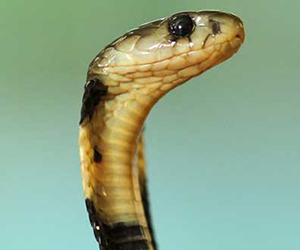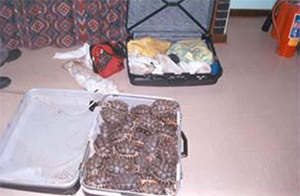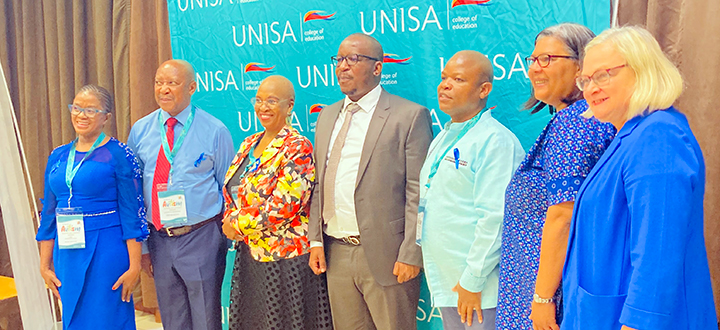College of Law
Poachers are decimating SA’s reptiles - but does anyone care?
 tortoises used to be found by the hundreds in fields in the Western Cape. Now there are probably more of them in pet shops and homes overseas than in their natural habitats.
tortoises used to be found by the hundreds in fields in the Western Cape. Now there are probably more of them in pet shops and homes overseas than in their natural habitats.
South African snakes, from the harmless mole snake to the venomous Cape cobra, are suffering a similar fate. Mole snakes are popular as pets while Cape cobras are prized among collectors internationally because they are so venomous.
Frogs, lizards, geckos, toads and chameleons are also in demand, and as far as collectors are concerned, the more endangered or dangerous they happen to be, the more they are prepared to pay.
Plundering in the name of collecting
"It’s all about status. Reptile collectors pride themselves on owning the rarest, most endangered, venomous or poisonous species. There is a massive market for reptiles overseas and collectors tend to love South African species," says Prof Friedo Herbig of the School of Criminal Justice in the College of Law.

Prof Friedo Herbig
Reptile poaching in South Africa has escalated into wholesale plunder since the advent of the world wide web, which has made it possible to place online orders for any species under the sun, says Herbig, a former marine conservation inspector turned conservation crime academic and researcher.
The animals, easily picked up in their natural habitats, are shipped to their destinations in shocking conditions. Tortoises, for instance, are starved and dehydrated before and during the voyage, often stuffed into suitcases, with the holes in their shells for their heads and legs taped up so that they cannot move, make a sound, urinate or defecate.
High death rates
Between 35% and 55% of poached tortoises and other reptiles die during the journey but this does not seem to deter the poaching trade. The animals are shipped out of the country in large numbers – numbers sufficient to ensure a profit even if a third or more of the poached reptiles are dead on arrival.
Not surprisingly, many reptiles targeted by poachers for collectors or pet owners are becoming increasingly scarce. "Tortoises are being decimated. You hardly see them anymore," he says, adding that the repercussions of reptile poaching are far graver than many people realise.
"Reptiles are the barometers of environmental health. If there are issues with reptiles, we know there are other environmental issues as well. If reptile numbers decline, the implications for farmers and crop damage can be severe," Herbig says, pointing to the role reptiles play in keeping pest populations, from rodents to mosquitoes, in check. "Everything has its niche role and the role played by reptiles is larger than we think. When they’re gone, they’re gone."
However, neither the general public nor the law enforcement authorities seem overly perturbed about the phenomenon of reptile poaching.
On the part of the public, Herbig puts this down to apathy and herpetophobia – fear of reptiles. "Many people don’t like 'creepy crawlies' and see reptiles as pests. They don’t care if they hear that a snake species is disappearing. Unlike the poaching of iconic species like rhinos or elephants, reptile poaching isn’t newsworthy so there is no pushback."
Why reptiles are falling through the cracks

Poached tortoises in suitcase
As for the nature conservation agencies and the law enforcement authorities, there are two main obstacles to action being taken to curb reptile poaching.
"One is that nature conservation agencies are understaffed and overstretched. There are so many animal species to protect that reptiles are falling through the cracks. They are right at the bottom of the pile," he says.
"The other problem is legislation and its enforcement. Each province has its own nature conservation ordinance to protect species and there is little to no uniformity between provinces. We have nine different provinces and nine different sets of grassroots conservation legislation, which makes it very difficult to adopt a concerted approach."
Even when there are arrests, conviction rates are very low. "Offenders usually get a slap on the wrist despite the inhumanness of the crime," says Herbig. "Cruelty is stretched to the limit in the live transport of birds and animals, but the judicial system does not take this into account."
Urgent overhaul needed
What is needed, says Herbig, is an overhaul of the legislation – along the lines of the Road Traffic Act. "All the different provincial traffic ordinances were consolidated under the Road Traffic Act so that no matter where you are, the same rules apply. We need a similar consolidation with nature conservation legislation. This is a mammoth task that requires political will, but if we don’t start, we will never make progress against poaching."
Education is another crucial weapon in the fight against conservation crime, Herbig says. "Apathy in our society makes it so easy for poachers to get away with it. Children should be learning in primary school about how important all species, including reptiles, are to the environment, to the globe, to our health and wellbeing. We can’t carry on using nature as we see fit."
* Submitted by the Research Support Directorate
** The first body image was sourced from pxhere (pxhere.com)
Publish date: 2021-05-31 00:00:00.0

 Young Unisa doctoral graduate joins elite Lindau Nobel Laureate group
Young Unisa doctoral graduate joins elite Lindau Nobel Laureate group
 Education MEC addresses Unisa autism seminar
Education MEC addresses Unisa autism seminar
 Seven Unisans nominated for the NSTF-South32 Awards 2023/2024
Seven Unisans nominated for the NSTF-South32 Awards 2023/2024
 Unisa awards posthumous honorary doctorate to literary maven, OK Matsepe
Unisa awards posthumous honorary doctorate to literary maven, OK Matsepe
 From humble beginnings to academic leadership
From humble beginnings to academic leadership